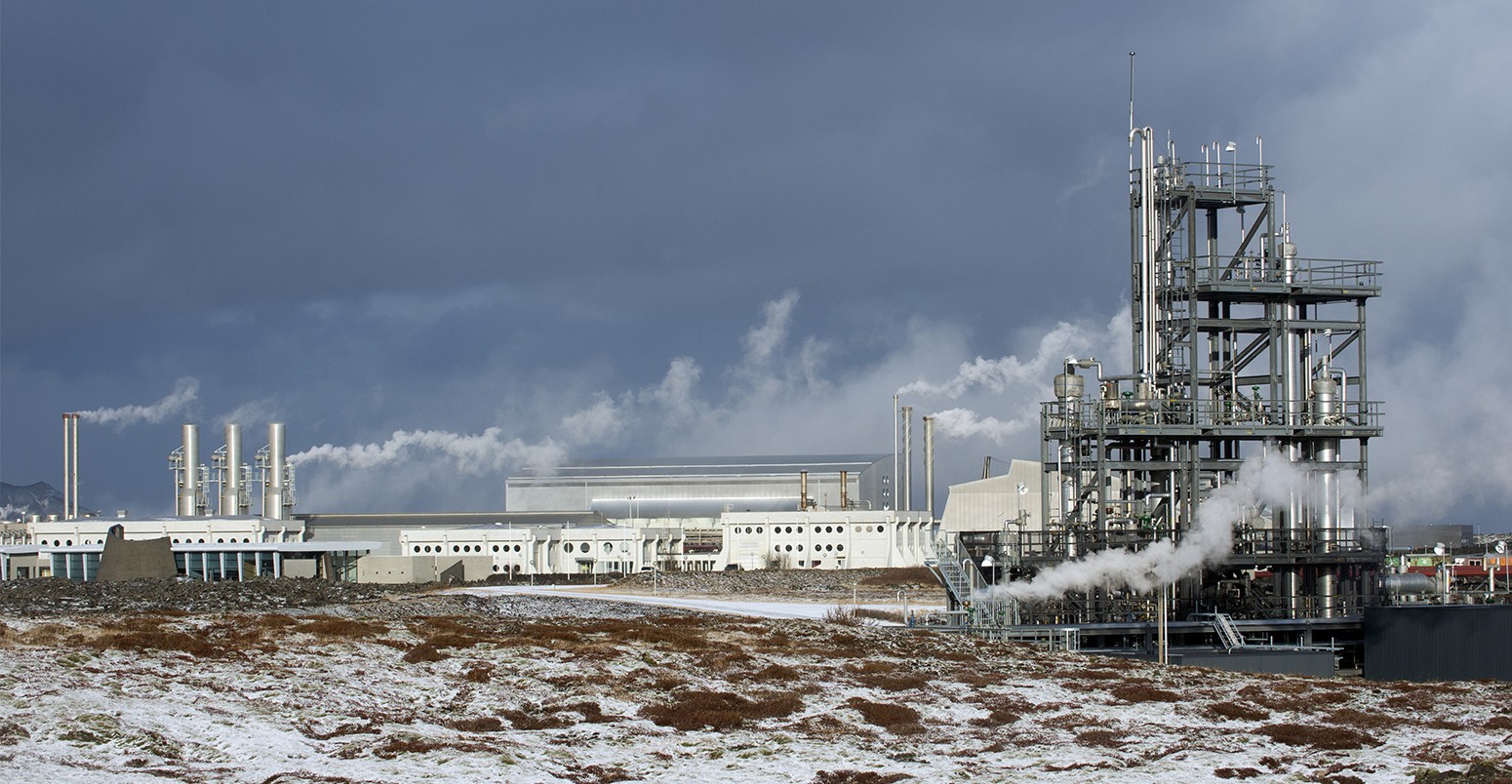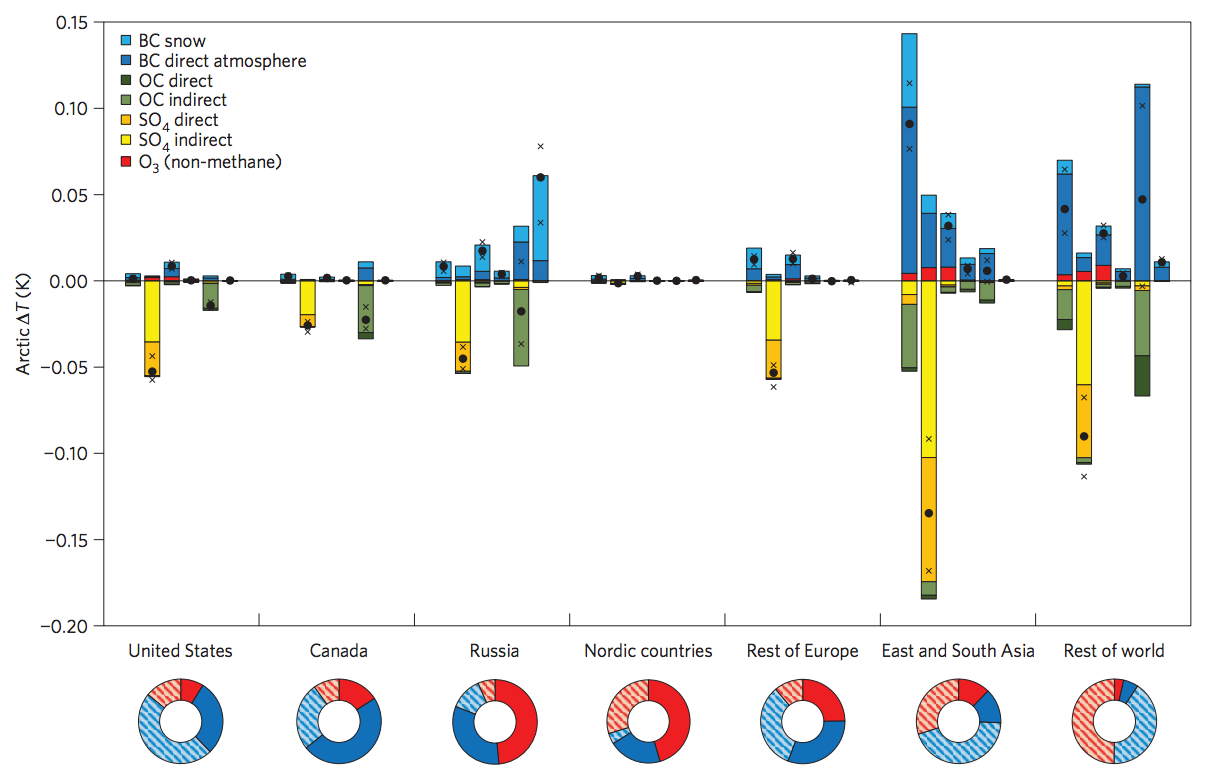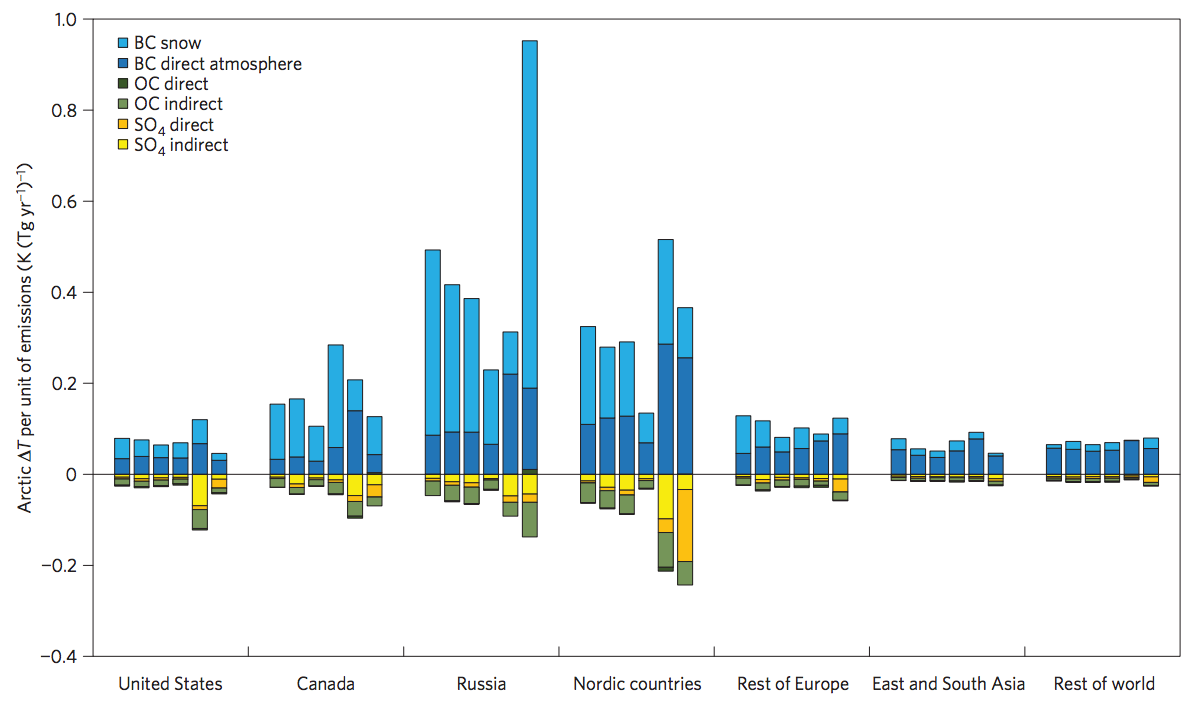
Curbing air pollutants could lessen Arctic warming by 0.2C by 2050
Robert McSweeney
12.01.15Robert McSweeney
01.12.2015 | 4:02pmFrom forest fires in Russia to gas flaring in Canada, a new study traces the air pollutants emitted across the northern hemisphere that are affecting the Arctic climate.
Reducing emissions of these pollutants could help slow temperature rise in the Arctic and the melting of sea ice, the lead author tells Carbon Brief.
Short-lived pollutants
Human activities emit more carbon dioxide than any other greenhouse gas. It is the main focus of discussions around ways to tackle climate change, both because of its abundance and because once in the atmosphere it can stay there for centuries.
But there is also a group of ‘short-lived’ gases and pollutants that affect the Earth’s climate.
As their name suggests, short-lived pollutants don’t hang around in our atmosphere very long. Black carbon (soot), sulphur dioxide, nitrogen oxides, volatile organic compounds (VOCs), organic carbon and ozone all have lifetimes of around a month.
In the new study, published in Nature Climate Change, researchers from Norway, Sweden, Canada and the US look at how emissions of these pollutants across the northern hemisphere can – directly and indirectly – influence the climate in the Arctic.
The new study pinpoints where in the world these pollutants are coming from and how cuts could help stave off rapid warming in the Arctic.
Warming and cooling
Short-lived pollutants don’t all affect Arctic climate in the same way. Some, such as sulphates and organic carbon, have a cooling effect by scattering incoming radiation from the sun. Others, such as ozone and black carbon, have an overall warming effect by absorbing the sun’s energy, which warms the surrounding air.
Black carbon has the added effect of making Arctic ice more susceptible to melting. When the soot settles out of the atmosphere and onto the bright white ice, it darkens the surface, meaning it absorbs more of the sun’s energy, warming the ice up.
Using emissions data from 2010, the researchers ran their climate models over and over again, analysing the impact on temperature of different sources of each pollutant spanning right across the northern hemisphere.
Although the pollutants are short-lived, each model run simulated 200 years of the Earth’s climate, giving the climate system time to adjust fully to their impact.
The result, shown below, breaks down each pollutant by source and region according to its average annual effect on Arctic temperatures. Bars extending above the zero line indicate a warming effect, while bars underneath the line show a cooling impact. The colour of the bars indicates which pollutant it refers to, and the black dots on each bar show the overall effect once both warming and cooling influences are factored in.

Average annual Arctic temperature impact of each pollutant, by source and region. Includes black carbon (BC), organic carbon (OC), sulphates (SO4) and ozone (O3). Each bar represents the different emission sources, from left to right: domestic, energy/industry/waste, transport, agricultural waste burning, grass/forest fires, and flaring. The black dots are the total overall impact on temperature. The doughnuts illustrate how much of the Arctic warming (red) and cooling (blue) comes from forcing within the Arctic (solid fill) versus outside the Arctic (striped). Source: Sand et al. (2015)
You can see from the size of the bars that the biggest impacts on Arctic temperature come from East and South Asia and the rest of the world. Domestic heating and cooking are two of the main sources of short-lived pollutants, the paper says. Traditional fuel sources such as wood and coal produce large amounts of black carbon when burnt.
The authors also provide an extra level of information in the shape of the doughnuts underneath the bar charts. Pollutants can warm and cool the Arctic without actually being blown there from where they were emitted, says lead author Dr Maria Sand, a senior researcher at the Center for International Climate and Environmental Research (CICERO) in Oslo. For example, black carbon emitted in Europe can warm the climate locally, which affects wind patterns over Europe and, in turn, how much warm air is carried to the Arctic. This what the the doughnuts illustrate, Sand tells Carbon Brief:
The solid fill represents the local forcing in Arctic, which is the emissions that actually reached into the Arctic; while the striped fill represents this remote effect.
The researchers also produced a similar chart (see below) for the relative impact of each pollutant – i.e. how much Arctic temperatures change for every billion kilograms of pollutant emitted.
Comparing the two charts, you can see that Asian emissions have a smaller relative warming effect on the Arctic than, say, Russian emissions, but the sheer volume of pollution means the overall impact on temperature from Asia is larger. As the paper notes:
[The chart] shows that Arctic surface temperature is most sensitive to flaring emissions from Russia, followed by forest fire and flaring emissions from the Nordic countries.

Average annual Arctic temperature impact of each short-lived pollutant, by source and region, per unit of emissions. For explanation of key, see earlier chart. Source: Sand et al. (2015)
Delaying rapid warming
Cutting short-lived pollutants could help curb warming in the Arctic, where temperatures are rising more than twice as fast as the global average, the paper says.
Because these pollutants have short lifetimes in the atmosphere, the Arctic wouldn’t have to wait long to feel the effect of reduced emissions, the paper says. The benefits could even be realised within a politician’s term of office, Sand says in a press release.
The study estimates that a “stringent, but technically-feasible” mitigation strategy could see a 0.2C reduction in Arctic temperature rise by 2050.
While reducing short-lived pollutants could help limit temperature rise in the near-term, cutting carbon dioxide emissions should still be the backbone of global mitigation strategies, Sand tells Carbon Brief:
Even if [carbon dioxide] reductions are made, they may not be achieved in time to delay the rapid warming and melting of the Arctic. This may then best be achieved by also targeting short-lived emissions, especially those that trigger snow melting and [an] earlier spring season in the Arctic.
And it wouldn’t just be the climate that benefits, the paper notes, many of these pollutants also impair air quality, so fewer emissions would mean cleaner air as well.
Main image: Power plant in arctic landscape. © Pete Saloutos/Blend Images/Corbis.
Sand, M. et al. (2015) Response of Arctic temperature to changes in emissions of short-lived climate forcers, Nature Climate Change, doi:10.1038/nclimate2880.

